For education orders please call 1-877-290-8256.

 We need your help! We need your help!
We are currently gathering information to help us design a new simulation based curriculum product focusing on the atmosphere, weather and climate.
If you teach Earth Science, we would love to hear your thoughts.
To complete a brief survey and help us make another great product, please click on the link below:
Thank you in advance for your time and assistance.
Thank you!
Welcome again to our monthly newsletter with features on exciting celestial and earth science events, product reviews, tips & tricks, and a monthly sky calendar. We hope you enjoy it!


Long winter nights allow observation of almost all the stars of all the seasons except summer, including two unusual “morning stars” Mars and Saturn. Credit: Starry Night Software.
We are now only a few weeks away from the winter solstice on December 22. Anyone who lives in northern latitudes must have noticed how late the sun is rising and how early the sun is setting, especially since the end of Daylight Saving Time earlier this month.
Most people think of the winter solstice as the shortest day of the year, but stargazers tend to see it as the longest night of the year. The Sun is above the horizon roughly 9 hours, varying with latitude. Subtracting twilight, the night is fully dark for almost 12 hours.
One result of this long night, combined with the southern position of the sun, is that a very large part of the night sky can be seen in one night. As evening twilight ends, the “autumn” constellations fill the sky: Cygnus, Pegasus and Aquarius. As morning twilight begins, the “spring” constellations are visible: Hercules, Boötes, and Virgo. About the only constellations not visible at some point during the night are the ones right close to the Sun, such as Ophiuchus, Sagittarius, and Scorpius.
During the months between autumn equinox and winter solstice, the lengthening of the night almost keeps pace with the sun’s movement against the stars, so that the constellations visible at the end of evening twilight hardly seem to change. Pegasus hangs high in the southern sky for months on end. At the other end of the night, new constellations appear rapidly out of the dawn.
The opposite occurs once winter solstice is past: the morning sky changes hardly at all, while the autumn constellations rapidly disappear into evening twilight.
The long December nights allow us to take advantage of these oddities. In particular, the late rising of the sun means that many people need to be up well before sunrise to get to work. If you can get up just a little bit earlier, you can get a jump on the spring constellations.
In particular, in the next few weeks between now and solstice, an early riser can observe two “morning stars.” These are not the usual suspects, Mercury and Venus, but rather two old friends only recently emerged from behind the sun: Mars and Saturn.
In the accompanying chart, the positions of the planets are shown for tonight, November 30, and the orange trails show how they will move between now and December 22. Mars’ trail is much longer because it is moving much faster because of its relative closeness to Earth.
By a happy coincidence, both planets are currently paired with bright stars, Regulus and Spica respectively. Both planets are also on the rise in brightness, but for different reasons.
Both planets are getting brighter because they’re getting closer. Mars is moving towards opposition on March 3, while Saturn is moving towards opposition on April 15. At present both planets are just slightly brighter than the stars with which they are paired, but both will get much brighter by the time they reach opposition, especially Mars.
Geoff Gaherty
Geoff has been a life-long telescope addict, and is active in many areas of visual observation; he is a moderator of the Yahoo "Talking Telescopes" group.
[Top of Page]

Last month we examined the birthplace of stars—huge clouds of gas and dust found in interstellar space.
But what happens to these stars once they begin nuclear fusion and become full-fledged members of the stellar community? It seems that after a short and somewhat turbulent “childhood” the star settles down as it consumes its nuclear fuel. During this “adult” phase, its size and luminosity remain relatively stable.
 Let’s examine alpha Centauri, a star not unlike our own Sun. Situated in the southern constellation of Centaurus, it lies about 4.3 light years from our solar system. With a mass and luminosity slightly larger than the Sun, it is also about the same age, roughly 5 billion years. Like the Sun, it can probably look forward to another 5 billion years of blissful existence. Let’s examine alpha Centauri, a star not unlike our own Sun. Situated in the southern constellation of Centaurus, it lies about 4.3 light years from our solar system. With a mass and luminosity slightly larger than the Sun, it is also about the same age, roughly 5 billion years. Like the Sun, it can probably look forward to another 5 billion years of blissful existence.
Note: Alpha Centauri is actually a multiple star system. The reference here is to the brightest member, alpha Centauri A.

It is interesting and instructive to locate a stars on a graph which shows luminosity or absolute magnitude on the vertical axis and surface temperature or spectral class on the horizontal axis. Such a graph is shown below. It is known as a Hertzsprung-Russell diagram. Note that stars are not scattered at random but are gathered in distinct groups. The red line going from top left to bottom right represents the group known as the Main Sequence. Alpha Centauri is a Main Sequence star and remains there during its well-behaved adult life.
In contrast, Alnilam or epsilon Orionis, is a supergiant star forty times a massive and 375 000 as luminous as the Sun. It is estimated to be only about four million years old but already near the end of its life! Note its position on the H-R diagram shown below.
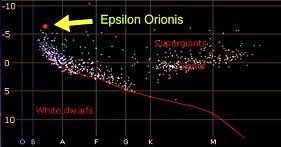 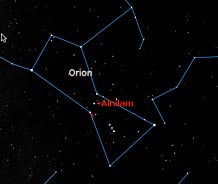
What is happening here? It turns out that the rate at which stars consume their nuclear fuel depends on their mass. The more massive the star, the faster it consumes its fuel.
But what happens when the fuel runs out? Stay tuned: we’ll look at how stars die in the next issue of Starry Night Times.
Further Study
The H-R diagram can be found in Starry Night under the Status tab along the left side of the program window. In a dark sky, point to a star and it will show as a red dot in the H-R diagram.
Question: are any of the seven stars in the Big Dipper Main Sequence stars?
Answer to last month’s question:
Three emission nebulae, all found in the constellation Sagittarius are M8 (Lagoon nebula), M17 (Omega nebula) and M20 (Trifid nebula).
Herb Koller
[Top of Page]

Star of Bethlehem — 3 B.C.
Press the Step time forward button to step through the close conjunction of Venus with Jupiter in Leo (near Regulus), culminating with a closet approach on August 12, 3 BC. Some scholars believe that this was the first appearance of the "star" which prompted the Wise Men to go to Judea seeking a King, the second being the Jupiter-Venus conjunction 10 months later on June 17, 2 BC.
Star of Bethlehem — 2 B.C.
Press the Step time forward button to step through the extremely close conjunction of Venus with Jupiter in Leo (near Regulus), culminating with a closest approach on June 17, 2 BC. Some scholars believe that this was the second appearance of the "star" which the Wise Men saw upon reaching Bethlehem, the first being the prior Jupiter-Venus conjunction 10 months earlier.
Pedro Braganca
Education & Content Director
Starry Night® Education
[Top of Page]

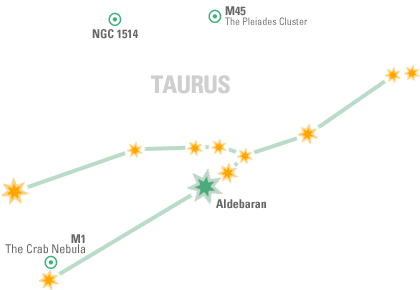
Marking the shoulder of The Bull, M45 The Pleiades is perhaps the most beautiful binocular target in the night sky. A telescope with low magnification will bring out a chain of stars running through the middle like a row of pearls.
M1 The Crab Nebula is what remains of a very bright supernova seen from Earth in 1054. It shone so brightly (about four times brighter than Venus) that it was quite visible during daylight hours.
NGC 1514 a nice planetary nebula with a dim outer shell and a bright inner shell; the inner shell has a blobbed appearance.
Aldebaran is the brightest star in Taurus and distinctly orange-hued. The giant star is in the late stage of its life-cycle: having burnt off its hydrogen, it's currently fusing helium into carbon.
Sean O'Dwyer
Starry Night® Times Editor
[Top of Page]
|
 |
 |
 |
 |
 |
 |
 |
Kids Dipper Clock
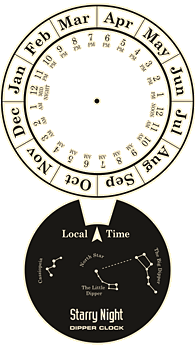
1. Cut out the two parts of the Dipper Clock template.
2. Punch a small hole through the center of each piece of the Dipper Clock template.
3. Center the small, dark inner circle over the larger, outer circle of the Dipper Clock.
4. Fasten the two halves together with a paper fastener (brad).
5. Your Dipper clock is now ready to use. (To tell time using your Dipper Clock you will need a clear night sky.)
6. Go outside on the first clear night and stand facing north. If you are facing the Big Dipper you are facing north.
7. Turn the outer circle of your Dipper Clock so the present month is at the top of the dial. The red-filtered flashlight will help you read the Dipper Clock without losing your night vision.
8. Look at the Big Dipper in the sky. Turn the inner circle of the Dipper Clock so the clock’s Dipper has the same orientation as the Big Dipper in the sky.
9. The notched window of your Dipper Clock now shows you the time of night. (The Dipper Clock shows standard time. If you are on daylight savings time, add one hour to the time your Dipper Clock shows.)
10. You can also use the Dipper Clock to predict the orientation of the Dipper at different times of night through the year.
|
 |
 |
Pedro Braganca
Education & Content Director
Starry Night® Education
|
 |
 |
 |
 |
 |
 |
 |
Flip Your View
Another way of modifying Starry Night’s screen appearance to match your telescope is to flip your view.
You can flip your view horizontally, vertically, or in both directions, to match what you see through your telescope.
You flip your view by choosing Flip: Horizontal, Vertical or Horizontal and Vertical from the Options menu.
Pedro Braganca
Education & Content Director
Starry Night® Education
|
 |
 |
 |
 |
 |
 |
 |
Follow us at
• twitter.com/starrynightedu
|
 |
 |
 |
 |
 |
 |
 |
Moon Phases
 Fri., Dec. 2 Fri., Dec. 2
4:52 a.m. EST
First Quarter Moon
The First Quarter Moon rises around 1 p.m., and sets around 1 a.m.
 Sat., Dec. 10 Sat., Dec. 10
9:36 a.m. EST
Full Moon
The Full Moon of Dec. is usually called the Oak Moon. In Algonquian it is called Cold Moon. Other names are Frost Moon, Winter Moon, Long Night’s Moon, and Moon Before Yule. In Hindi it is known as Margashirsha Poornima. Its Sinhala (Buddhist) name is Unduvap Poya. The Full Moon rises around sunset and sets around sunrise, the only night in the month when the Moon is in the sky all night long. The rest of the month, the Moon spends at least some time in the daytime sky.
 Sat., Dec. 17 Sat., Dec. 17
7:48 p.m. EST
Last Quarter Moon
The Last or Third Quarter Moon rises around 11 p.m. and sets around noon. It is most easily seen just after sunrise in the southern sky.
 Sat., Dec. 24 Sat., Dec. 24
1:06 p.m. EST
New Moon
The Moon is not visible on the date of New Moon because it is too close to the Sun, but can be seen low in the east as a narrow crescent a morning or two before, just before sunrise. It is visible low in the west an evening or two after New Moon.
Observing Highlights
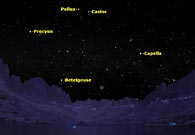
Sat., Dec. 10
Dawn
Total Lunar Eclipse
This eclipse will be seen in its entirety in eastern Asia, Australia, Oceania, and Alaska. The Moon will rise eclipsed in the early evening in Europe and Africa, and set eclipsed just before dawn in western North America. The graphic shows how it will look just before dawn in central California, surrounded by first magnitude stars.
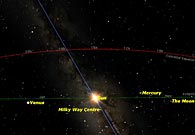
Thu., Dec. 22
12:30 a.m. EST
Solstice
Winter solstice in the northern hemisphere, summer solstice in the southern hemisphere. The Sun is at its farthest southern declination, and is 6.5 degrees away from the center of the Milky Way. This is exactly the same “alignment” as will occur on Dec. 21 2012, yet no catastrophes have been predicted for this year, just as none will occur next year. Because of the extreme difference in brightness between the Sun and the Milky Way, this “alignment” is observable only in a computer simulation.
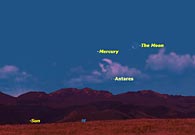
Thu., Dec. 22, and Fri., Dec. 23
Dawn
Close encounter between Mercury and the Moon
The Moon will be just to the right of Mercury on the Dec. 22 (shown here) and just to the left of Mercury on the Dec. 23.
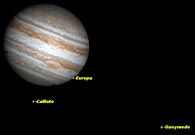
Tue., Dec. 27
10:52 p.m. EST
Jupiter satellite show
Three of Jupiter’s moons will put on a fine show tonight. Callisto will be in an unusual position due south of the planet because of the extreme tilt of the plane of Jupiter’s moons this year. Europa will be moving off from in front of Jupiter on one limb while its shadow begins a transit on the opposite limb. Ganymede, well off to the right, will still be casting its shadow just below Europa. Finally, the Great Red Spot will be perfectly placed right in the middle of all this.
Planets
Mercury is well placed in the eastern sky before sunrise for the last half of the month.
Venus is low in the evening sky after sunset all month. The waxing crescent Moon will pass close to Venus on Mon. Dec. 26 and Tue. Dec. 27.
Mars spends all of Dec. in the morning sky in Leo. It now outshines nearby Regulus and grows from 7 arc seconds to 9 arc seconds during the month, large enough to reveal its polar cap and dark surface markings in a 6-inch (150-mm) telescope. It is now approaching magnitude 0, one of the brightest objects in the morning sky. Jupiter continues to be well placed in the evening sky all month on the border between Aries and Pisces.
Jupiter and Venus are the brightest objects in the night sky other than the Moon.
Saturn is visible before dawn in the eastern sky. It now shines brighter than nearby Spica.
Uranus is well placed in the early evening in Pisces all month.
Neptune is well placed in the early evening in Aquarius all month.
Geoff Gaherty
Data for this calendar have been derived from a number of sources including the Observer's Handbook 2011 of the Royal Astronomical Society of Canada, Starry Night® software, and others. Only events with a reasonable possibility for Northern Hemisphere observers, or those events with some other significance, are given. All times shown are U.S. Eastern Time.
|
 |
 |
 |
 |
 |
 |
 |
 |
 |
 |
December 8, 2011
NSTA - Seattle, WA
Booth No. 333
|
 |
 |
 |
 |
 |
 |
 |
Educational Inquiries and Sales
Please contact us for all education inquiries. EDUCATION ORDERS 1-877-290-8256
|
 |
 |
 |
 |
 |
 |
 |
Send us your feedback
Do you have a question, comment, suggestion or article idea to pass along to Starry Night® Times?
Click here to get in touch with us.
|
 |
 |
 |
 |
 |
 |
 |
Starry Night® is the world's leading line of educational astronomy software and DVDs. Visit store.starrynight.com to see all the great products we offer for everyone from novice to experienced astronomers.
To subscribe sign up here.
Starry Night® is a division of Simulation Curriculum Corp.
Simulation Curriculum Corp.
Starry Night® Education
11900 Wayzata Blvd.
Suite 126
Minnetonka, MN 55305
Tel:
1-866-688-4175
|
 |
 |
|



 EDUCATION ORDERS 1-877-290-8256
EDUCATION ORDERS 1-877-290-8256

 Let’s examine alpha Centauri, a star not unlike our own Sun. Situated in the southern constellation of Centaurus, it lies about 4.3 light years from our solar system. With a mass and luminosity slightly larger than the Sun, it is also about the same age, roughly 5 billion years. Like the Sun, it can probably look forward to another 5 billion years of blissful existence.
Let’s examine alpha Centauri, a star not unlike our own Sun. Situated in the southern constellation of Centaurus, it lies about 4.3 light years from our solar system. With a mass and luminosity slightly larger than the Sun, it is also about the same age, roughly 5 billion years. Like the Sun, it can probably look forward to another 5 billion years of blissful existence.









